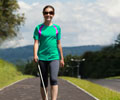A new therapy of injecting a therapeutic molecule called QR-110 for people suffering from one of the most common forms of childhood blindness showed 'very promising' results.

‘Leber congenital amaurosis is an inherited retinal disease which can be corrected by therapeutically injecting QR-110 to improve the sight.’





The patients were injected at regular intervals, and the results, published in Nature Medicine, showed QR-110, had no adverse effects and vision had improved in patients at three months. One patient responded exceptionally well and after six weeks of treatment self-reported substantial visual improvements and, for the first time in decades, was able to see lights with increasing clarity and brightness - but only in the treated eye. At four months the patient was able to read the first three lines of the standard ETDRS eye test, showing the visual acuity (clarity of vision) has improved from light perception to 20/400 vision.
The clinical trial was undertaken by study collaborators at the University of Pennsylvania, University of Iowa and University of Ghent.
Co-author Professor Mike Cheetham (UCL Institute of Ophthalmology) led the pre-clinical research and worked with scientists from ProQR Therapeutics, Netherlands, to develop the QR-110 treatment.
"Our work on helping to develop QR-110, used patient stem cells to make a 'retina in a dish' to show QR-110 could potentially work for this devastating early onset blindness," he said.
Advertisement
"Hopefully the patients will continue to improve and more patients can be treated in the near future."
Advertisement
The pre-trial research team, led by Professor Cheetham, developed proof of concept that molecules, called antisense oligonucleotides, could silence the effect of this mutation so that the gene splicing machinery can make the correct protein. They then worked with ProQR to develop a clinically applicable antisense oligonucleotide and found that the molecule QR-110 was most effective at achieving this and was able to restore levels of normal CEP290 protein in cells from individuals with LCA10. This was possible by using a 'retina in a dish' model made from LCA10 patient stem cells, and the results showed improved photoreceptor structure. QR-110 was also very specific in targeting the mutation without influencing other parts of the genome (genetic code).
The researchers established that QR-110 was well tolerated in animal models, and reached all layers of the retina, lasting a suitable length of time in the eye, making it a promising candidate for clinical testing. This work led to the human clinical trials now being reported on.
Professor Cheetham added: "I think this opens up the possibility of treating many forms of inherited blindness with drugs similar in design to QR-110, small antisense oligonucleotides that are specifically to correct genetic faults."
Director of Research, Dr Neil Ebenezer from Fight for Sight, who provided some of the funding for the preclinical work, said: "We helped to fund the initial research that proved this genetic technique could work in the lab, and it was this groundwork that led to the clinical trial. It is fantastic that the clinical trial is now bringing us one step closer to having an effective treatment for patients with Leber congenital amaurosis."
Source-Eurekalert












